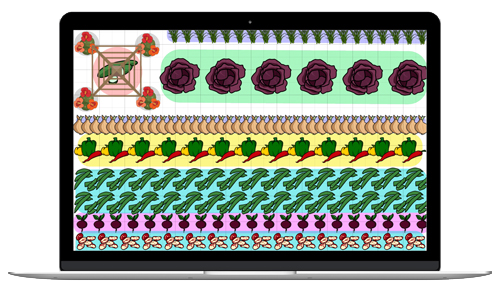
Planting, Growing, and Caring for Tulips
The Almanac Garden Planner - Use It Free for 7 Days!
Plan your 2025 garden with our award-winning Garden Planner.
Tulip flowers may be single, double, ruffled, fringed, or lily-shaped, depending on the variety.
- ‘Cracker’ tulip: purple, pink, and lilac petals; midseason bloomer
- ‘Ile de France’: red blooms on stems to 20 inches tall; midseason bloomer
- ‘Marilyn’: large, ruffled, candy cane-color flower; late-season bloomer
- ‘Spring Green’: creamy-white petals feathered with green; late-season bloomer
- ‘Renown’: hot pink, egg-shape flower; late-season bloomer
Wild, or “species,” tulips are small in size, ranging in height from 3 to 8 inches. They are tougher than hybrids. Rock and herb gardens are ideal places to plant them. They look stunning when planted in large groupings.
- For early to midspring bloom time: Tulipa bakeri, T. batalinii, T. humilis, T. kaufmanniana, T. turkestanica
- For later blooming time: T. linifolia, T. neustreuvae, T. sprengeri, T. vvedenskyi
- For multicolor varieties: T. biflora, T. greigii ‘Quebec’, T. praestans ‘Fusilier’ and ‘Unicum’, T. tarda, T. turkestanica
- For a container: T. kaufmanniana ‘Goudstuk’
- For (mottled) foliage: T. greigii (mottled or striped), T. fosteriana ‘Juan’, T. kaufmanniana ‘Heart’s Delight’
- For fragrance: T. aucheriana, T. biflora, T. saxatilis, T. sylvestris, T. turkestanica
- For warmer regions: Lady tulip (T. clusiana), Candia tulip (T. saxatilis), and Florentine tulip (T. sylvestris) overwinter in the South or mild-winter areas of the West (Zones 8 to 10) without the need of a chilling period
There are so many beautiful varieties of tulips. Explore catalogs and experiment in your garden!
ADVERTISEMENT
Unfortunately, it is unlikely that the tulip bulbs would rebloom during the same year. You can remove any remaining flowering stalks, but keep the leaves, if they are still there, as that will allow the plant to make food for the coming winter/spring. Some tulip types may not flower the following year, but others may bloom for several years.
In most northern areas, you can keep the bulbs in the ground over winter. (If they are in containers, though, they will need extra protection.) In warm climate areas (Zones 7b to 10), to increase the chance for healthy blooms next year, you may need to dig bulbs up after foliage has browned/died and store for about 10 to 12 weeks in a cool/dark place (such as an unheated garage, or in a bag in the refrigerator crisper away from fruit/veggies, some of which emit ethylene gas that can damage the bulbs/developing flowers [ideally, it’s best to use a separate refrigerator away from food]) to give them a needed period of cold. Alternatively, in mild climates you can treat your tulips as annuals and buy new pre-chilled bulbs for the next planting season.
This past season I planted 150 tulip bulbs. They were all so beautiful. Then along came the high winds and lots of rain. I no longer have the flowering plants so can I cut them down to the roots now and leave the bulbs in the ground or do I need to take the bulbs up and replant them next season ?
Hi Betty,
Sounds like you had quite the tulip display!
After tulips have bloomed, you want to deadhead the flower blooms, but keep the leaves/foliage and let it die back naturally before removing it. This process can take several weeks. That is how the bulbs gather and store energy for next year’s growing season. You can leave the bulbs in the ground for next season. The only time you need to dig them up is when bulbs are not producing flowers, at which time they can be replaced with new bulbs during the fall planting time.
Lol all my tulips are planted by volunteer squirrels!
Can I replant the bulbs if I take them out of the soil in next fall
Yes, you can transplant them anytime after their foliage has died back. At that point, they are done gathering energy for next year’s blooms and can be moved!
Once blooms have passed and leaves are dead, do I dig up the bulbs and store for next fall? Can my tulip bed be used for other flowers or vegetables?
Tulips, daffodils, crocuses, hyacinth, and several others are winter-hardy bulbs, meaning that they can (and should) remain in the ground through winter. They need a period of cold weather (winter) to encourage them to bloom in the spring.
Wow, Such a nice article. please don't stop posting keep it up! I am also a gardener lover and write about
My tulips have now finished flowering. Waiting for leaves to die down I have noticed that four of them have something that looks as if it has a seed pod where the flower was. Is it worth taking them off and planting them ?












